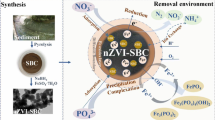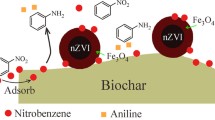Abstract
Biochar (BC) obtained by the co-pyrolysis of municipal sewage sludge (MSS) and sunflower seed shells (SSS) was utilized to support nanoscale zero-valent iron particles (nZVI) for the synthesis of a composite material (nZVI-BC) for Cr(VI) removal from aqueous systems. A series of characterization methods confirmed successful immobilization of nZVI on the surface of biochar with no aggregation. Batch experiments showed that the initial pH, initial Cr(VI) concentration, and nZVI-BC dose all significantly affected the Cr(VI) removal using nZVI-BC. The kinetics for Cr(VI) removal via nZVI-BC could be better explained by the pseudo-second-order (PSO) adsorption model. Adsorption isotherms analysis demonstrated the superior Cr(VI) removal capability of nZVI-BC in comparison to bare nZVI and BC. nZVI-BC can be reused after the regeneration process by applying 0.1 M H2SO4 and 0.1 M NaBH4 solutions. The reaction mechanism for Cr(VI) removal might involve its chemical reduction on the nZVI-BC surface. Overall, environmentally friendly nZVI-BC was highly efficient in Cr(VI) removal from aqueous systems.







Similar content being viewed by others
Data availability
The datasets used and/or analyzed during the current study are available from the corresponding author on reasonable request.
References
Alowitz MJ, Scherer MM (2002) Kinetics of nitrate, nitrite, and Cr(VI) reduction by iron metal. Environ Sci Technol 36:299–306
Bae S, Gim S, Kim H, Hanna K (2016) Effect of NaBH 4 on properties of nanoscale zero-valent iron and its catalytic activity for reduction of p -nitrophenol. Appl Catal B 182:541–549
Crane RA, Scott TB (2012) Nanoscale zero-valent iron: future prospects for an emerging water treatment technology. J Hazard Mater 211-212:112–125
Devi P, Saroha AK (2014) Synthesis of the magnetic biochar composites for use as an adsorbent for the removal of pentachlorophenol from the effluent. Bioresour Technol 169:525–531
Fu F, Ma J, Xie L, Tang B, Han W, Lin S (2013) Chromium removal using resin supported nanoscale zero-valent iron. J Environ Manag 128:822–827
Fu R, Zhang X, Xu Z, Guo X, Bi D, Zhang W (2017) Fast and highly efficient removal of chromium (VI) using humus-supported nanoscale zero-valent iron: Influencing factors, kinetics and mechanism. Sep Purif Technol 174:362–371
Geng B, Jin Z, Li T, Qi X (2009) Preparation of chitosan-stabilized Fe 0 nanoparticles for removal of hexavalent chromium in water. Sci Total Environ 407:4994–5000
Ho YS, McKay G (1999) Pseudo-second order model for sorption processes. Process Biochem 34:451–465
Huang P, Ye Z, Xie W, Chen Q, Li J, Xu Z, Yao M (2013) Rapid magnetic removal of aqueous heavy metals and their relevant mechanisms using nanoscale zero valent iron (nZVI) particles. Water Res 47:4050–4058
Jingge S, Mingzhu Z, Ying Y, Xiangrui K, Qiong D, Qianjiahua L (2017) Removal of chromium (VI) from water using nanoscale zerovalent iron particles supported on herb-residue biochar. J Environ Manag 197:331–337
Lv X, Xu J, Jiang G, Tang J, Xu X (2012) Highly active nanoscale zero-valent iron (nZVI)–Fe3O4 nanocomposites for the removal of chromium(VI) from aqueous solutions. J Colloid Interface Sci 369:460–469
Lv X, Qin X, Wang K, Peng Y, Wang P, Jiang G (2019) Nanoscale zero valent iron supported on MgAl-LDH-decorated reduced graphene oxide: enhanced performance in Cr(VI) removal, mechanism and regeneration. J Hazard Mater 373:176–186
Meng J, Wang L, Liu X, Wu J, Brookes PC, Xu J (2013) Physicochemical properties of biochar produced from aerobically composted swine manure and its potential use as an environmental amendment. Bioresour Technol 142:641–646
Miretzky P, Cirelli AF (2010) Cr(VI) and Cr(III) removal from aqueous solution by raw and modified lignocellulosic materials: a review. J Hazard Mater 180:1–19
Montesinos VN et al (2014) Highly efficient removal of Cr(VI) from water with nanoparticulated zerovalent iron: Understanding the Fe(III)–Cr(III) passive outer layer structure. Chem Eng J 244:569–575
PARK HJ, JEONG SW, YANG JK, KIM BG, LEE SM (2007) Removal of heavy metals using waste eggshell. J Environ Sci 19:1436–1441
Peng Y et al (2009) Montmorillonite-supported magnetite nanoparticles for the removal of hexavalent chromium [Cr(VI)] from aqueous solutions. J Hazard Mater 166:821–829
Sing KSW, Everett DH, Haul RAW, Moscou L, Pierotti RA, Rouquerol J, Siemieniewska T (1985) Reporting physisorption data for gas solid systems with special reference to the determination of surface-area and porosity. Pure Appl Chem 57(4):603–619
Su H, Fang Z, Tsang PE, Fang J, Zhao D (2016) Stabilisation of nanoscale zero-valent iron with biochar for enhanced transport and in-situ remediation of hexavalent chromium in soil. Environ Pollut 214:94–100
Sun Y-P, X-q L, Cao J, W-x Z, Wang HP (2006) Characterization of zero-valent iron nanoparticles. Adv Colloid Interf Sci 120:47–56
Sungjun B, Woojin L (2014) Influence of riboflavin on nanoscale zero-valent iron reactivity during the degradation of carbon tetrachloride. Environ Sci Technol 48:68–76
Tan X-f et al (2016) Biochar-based nano-composites for the decontamination of wastewater: a review. Bioresour Technol 212:318–333
Wang XS, Tang YP, Tao SR (2008) Kinetics, equilibrium and thermodynamic study on removal of Cr (VI) from aqueous solutions using low-cost adsorbent Alligator weed. Chem Eng J 137:529–541
Wang Z, Chen G, Wang X, Li S, Liu Y, Yang G (2020) Removal of hexavalent chromium by bentonite supported organosolv lignin-stabilized zero-valent iron nanoparticles from wastewater. J Clean Prod 267:1–11
Wu W, Yang M, Feng Q, McGrouther K, Wang H, Lu H, Chen Y (2012) Chemical characterization of rice straw-derived biochar for soil amendment. Biomass Bioenergy 47:268–276
Wu L, Liao L, Lv G, Qin F, He Y, Wang X (2013) Micro-electrolysis of Cr (VI) in the nanoscale zero-valent iron loaded activated carbon. J Hazard Mater 254–255:277–283
Xiang S, Cheng W, Nie X, Ding C, Yi F, Asiri AM, Marwani HM (2018) Zero-valent iron-aluminum for the fast and effective U(VI) removal. Chem Eng J 85:186–192
Xu X, Zhao B, Sun M, Chen X, Zhang M, Li H, Xu S (2017) Co-pyrolysis characteristics of municipal sewage sludge and hazelnut shell by TG-DTG-MS and residue analysis. Waste Manag 62:91–100
Xu C, Yang W, Liu W, Sun H, Jiao C, Lin A-j (2018) Performance and mechanism of Cr(VI) removal by zero-valent iron loaded onto expanded graphite. J Environ Sci 67:14–22
Xue W, Huang D, Zeng G, Wan J, Zhang C, Xu R, Cheng M, Deng R (2018) Nanoscale zero-valent iron coated with rhamnolipid as an effective stabilizer for immobilization of Cd and Pb in river sediments. J Hazard Mater 341:381–389
Yan W, Herzing AA, Kiely CJ, Zhang W-X (2010) Nanoscale zero-valent iron (nZVI): aspects of the core-shell structure and reactions with inorganic species in water. J Contam Hydrol 118:96–104
Yang-hsin S, Yu-tsung T (2010) Reaction of decabrominated diphenyl ether by zerovalent iron nanoparticles. Chemosphere 78:1200–1206
Yao Y, Gao B, Inyang M, Zimmerman AR, Cao X, Pullammanappallil P, Yang L (2011) Biochar derived from anaerobically digested sugar beet tailings: characterization and phosphate removal potential. Bioresour Technol 102:6273–6278
Yin X, Liu W, Ni J (2014) Removal of coexisting Cr(VI) and 4-chlorophenol through reduction and Fenton reaction in a single system. Chem Eng J 248:89–97
Zhang Y, Li Y, Li J, Sheng G, Zhang Y, Zheng X (2012) Enhanced Cr(VI) removal by using the mixture of pillared bentonite and zero-valent iron. Chem Eng J 185-186:243–249
Zhao B, Xu X, Xu S, Chen X, Li H, Zeng F (2017) Surface characteristics and potential ecological risk evaluation of heavy metals in the bio-char produced by co-pyrolysis from municipal sewage sludge and hazelnut shell with zinc chloride. Bioresour Technol 243:375–383
Zhao B, Xu X, Li H, Chen X, Zeng F (2018a) Kinetics evaluation and thermal decomposition characteristics of co-pyrolysis of municipal sewage sludge and hazelnut shell. Bioresour Technol 247:21–29
Zhao B, Xu X, Zeng F, Li H, Chen X (2018b) The hierarchical porous structure bio-char assessments produced by co-pyrolysis of municipal sewage sludge and hazelnut shell and Cu(II) adsorption kinetics. Environ Sci Pollut Res 25:19423–19435
Zhou Y, Gao B, Zimmerman AR, Chen H, Zhang M, Cao X (2014) Biochar-supported zerovalent iron for removal of various contaminants from aqueous solutions. Bioresour Technol 152:538–542
Zhu H, Jia Y, Wu X, Wang H (2009) Removal of arsenic from water by supported nano zero-valent iron on activated carbon. J Hazard Mater 172:1591–1596
Funding
This research work was supported by the National Key Research and Development Projects (ZX20200121) and the Fundamental Research Funds for the Central Universities (N180112012).
Author information
Authors and Affiliations
Contributions
XX, HL, and YL contributed to the study conception and design. Material preparation was performed by RZ and YH, and data collection and analysis were performed by XC and GF. The first draft of the manuscript was written by GF, and all authors commented on previous versions of the manuscript. All authors read and approved the final manuscript
Corresponding author
Ethics declarations
Ethics approval and consent to participate
Not applicable.
Consent for publication
Not applicable.
Competing interests
The authors declare no competing interests.
Additional information
Responsible Editor: Zhihong Xu
Publisher’s note
Springer Nature remains neutral with regard to jurisdictional claims in published maps and institutional affiliations.
Highlight
• Biochar as a carrier could effectively improve the dispersion of nZVI.
• NZVI-BC showed superior Cr(VI) removal capability than bare nZVI and BC.
• The PFO model could better fit the Cr(VI) removal process.
• The reduction of Cr(VI) mainly occurred on solid surface.
Supplementary information
ESM 1
(DOCX 1090 kb)
Rights and permissions
About this article
Cite this article
Chen, ., Fan, G., Li, H. et al. Nanoscale zero-valent iron particles supported on sludge-based biochar for the removal of chromium (VI) from aqueous system. Environ Sci Pollut Res 29, 3853–3863 (2022). https://doi.org/10.1007/s11356-021-15969-x
Received:
Accepted:
Published:
Issue Date:
DOI: https://doi.org/10.1007/s11356-021-15969-x




